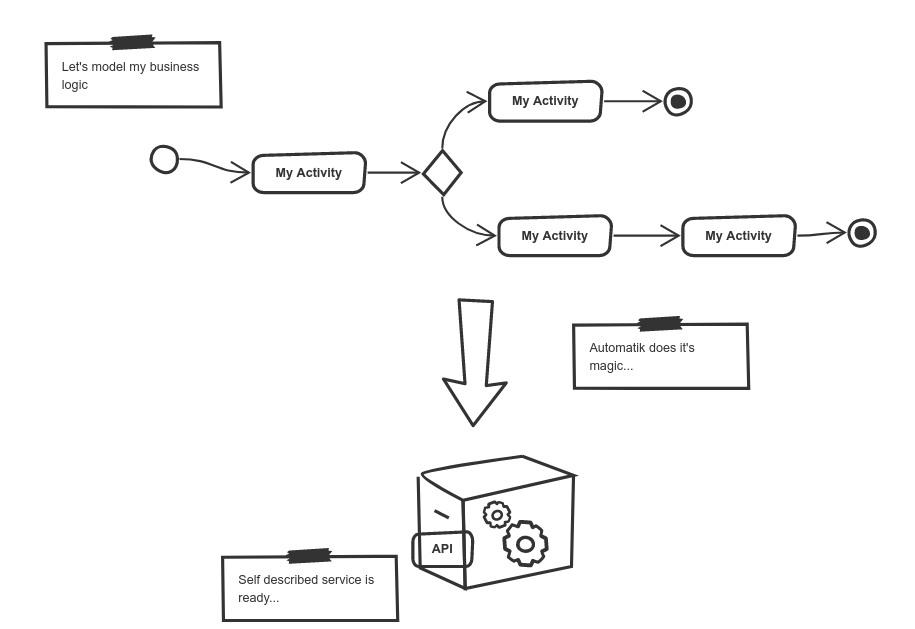What is Automatiko?

Overview
Automatiko is a toolkit that takes advantage of well established and known languages to build (but not limited to) self contained services. As the name might suggest its main goal is to enable users to automate their daily tasks, such as processing of emails, perform schedules actions, collect and transform data and many more.
By "well established and known languages" Automatiko means:
In addition to these already known in the market, a relatively new player is also supported in Automatiko:
-
Serverless Workflow (a Cloud Native Computing Foundation project)
Automatiko promotes the above mentioned languages as programming languages that can be used to build production ready services. It takes advantage of various constructs of these languages to provide services that are:
-
self described
-
API contract enabled
-
secured
-
easy to manage
-
integrated with other services
Why should you use Automatiko?
Before answering this fundamental question, we must take a look at its prerequisite:
Why should you use workflows?
Workflows in general are meant to capture business logic in a structured way. That is done either graphically (e.g. like BPMN and DMN do with forms of flow charts) or declaratively as it is done in Serverless Workflow. This gives us first benefit of using workflows:
| Visibility |
Visibility of business logic that can be applied in both design (development time) to make sure the business logic is expressed the way business demands it, as well as runtime to illustrate the current state of individual (or aggregated) instances.
Another important aspect of workflows is that they define data objects that are required for execution. This applies to workflows as well as individual workflow activities such as service tasks, operations and user interactions, and defines our second main benefit of using workflows:
| Domain data contract |
Domain data contract allows us to clearly define what is an input and what is an output of a given workflow and/or its individual activities. With this at hand your domain business logic is equipped with one of the most powerful tools - self description.
Next item on the list deals with isolation and security of your domain data. As workflows define the domain data model (as stated above), they are also responsible for data access security. Security not just from authorization point of view but also, and in many case equally important, isolation.
| Isolation |
Isolation is ensured on individual levels without any extra effort. Workflows are built around definitions and instances. A definition is a single artefact that is then initialized for each individual set of data which forms an instance. Each instance is kept isolated from others while still providing access to other instances at any point in time.
Another benefit is the availability of proven workflow tools. These tools help us get up and running quicker instead of attempting to build everything from scratch (which is certainly possible but in many cases not worth the effort). These tools include:
-
service invocation (orchestrating services via REST)
-
message exchange (Apache Kafka, MQTT, JMS and many more)
-
user interaction (assigned task to groups and individual, notification about pending work)
-
distributed time tracking (when workflow need to work for a given amount of time)
-
data driven actions (reacting to data changes to trigger actions)
-
and many more
| Workflow toolbox |
Out of the box tools that come with workflows and are directly available for use regardless of what domain they are used in.
The above list includes just a few of many benefits of using workflows. As always the choice is yours. In life everything is a process, so why not make use of real life approaches to model your business logic as well?
So why to use Automatiko?
Automatiko was designed and built with above principles in mind to provide developers with easy and powerful ways for defining their business logic. It was tailored to provide excellent support for a number of use cases, including:
-
event streams
-
Internet of Things (IoT)
-
human centric workflows
-
service orchestration
-
database record processing
You can examine these use cases in the Use Cases chapter and see them in action.
Automatiko is completely open source under Apache License, version 2.0. Automatiko is written in Java and takes advantage of all the modern frameworks and libraries which allow it to run on many environments including:
-
local environments on any of the popular OS - Windows, Linux, Mac
-
IoT devices such as Raspberry PI
-
Cloud deployments
-
Kubernetes
-
K3S (and K3D)
-
OpenShift
-
AWS
-
Automatiko allows you to use BPMN, Serverless Workflow, and DMN as programming languages for building services that automate your business logic, regardless of its domain.
Automatiko is not intended to replace other programming languages, but helps us embrace out of the box and proven workflow features that provide significant value with little not no effort on your side.
| Give Automatiko a try and share your feedback |
So enough talking, take Automatiko for a spin by checking out the many examples ready for you to run and modify. Just head to the Getting started chapter and try it! Don’t forget to share your feedback as this will allow us to make it even better.